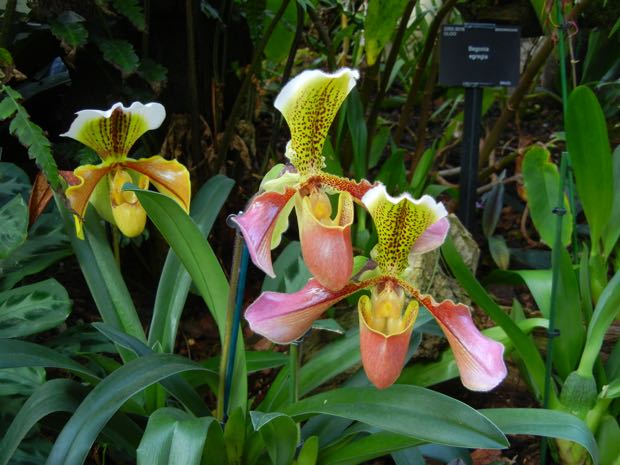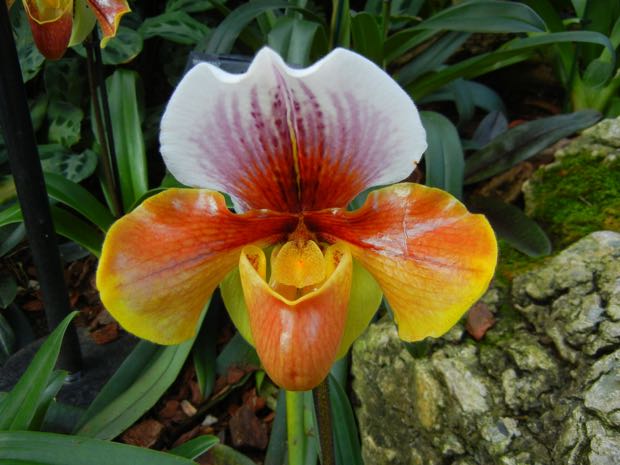Paphiopedilum, commonly known as Lady’s-slipper orchids, are captivating orchids that trace their origins to the lush jungles of the Far East, including Indonesia. These semiterrestrial orchids naturally thrive in humus-rich materials on the forest floor, nestled in pockets of humus on cliffs, and occasionally even in trees. Paphiopedilums are highly favored among orchid enthusiasts due to their stunning beauty and relatively easy care requirements, making them popular choices for home cultivation, whether under artificial lights or in a greenhouse.
Lighting:
Providing the appropriate lighting conditions for Paphiopedilums is relatively straightforward compared to other orchid varieties. These orchids thrive in shady conditions, making them well-suited for placement near east or west-facing windows in the home. If grown in a greenhouse, it’s essential to ensure shade is provided to prevent excessive light exposure. Aim for light intensity ranging from 1,000 to 1,500-foot candles. Fluorescent lighting is an excellent option for indoor cultivation, with two to four tubes suspended 6 to 12 inches above the leaves.
Temperature tolerance:
Paphiopedilums exhibit a wide temperature tolerance, and they are traditionally categorized into two groups: the warm-growing mottled-leaved types and the cool-growing green-leaved types. A third group, the strap-leaved multi-floral Paphiopedilums, which prefer slightly warmer conditions, is gaining popularity. Warm-growing types typically require nighttime temperatures around 60 to 65°F (15 to 18°C) and daytime temperatures ranging from 75 to 85°F (24 to 29°C) or even higher. Cool-growing types, on the other hand, thrive with nighttime temperatures between 50 to 60°F (10 to 15°C) and daytime temperatures of 75 to 80°F (24 to 27°C).
However, many growers successfully cultivate all Paphiopedilum types within the same temperature range. These orchids can tolerate nighttime temperatures in the 40s (°F) if necessary, as well as temperatures up to 95°F (35°C). During colder periods, it’s crucial to protect the plants from rot by minimizing humidity and avoiding moisture accumulation on leaves or in the crowns. Similarly, in hot conditions, increased shading, humidity, and air movement are essential to prevent burning.
Water availability is crucial for Paphiopedilums due to their lack of pseudobulbs. These orchids require a consistently moist growing medium—never too saturated but never allowing it to dry out completely. Watering once or twice a week is generally sufficient to maintain the desired moisture levels.
Humidity:
Moderate humidity ranging from 40% to 50% is ideal for Paphiopedilums. In a home environment, this can be achieved by placing the plants on trays of gravel partially filled with water, ensuring the plants are not sitting in water. In a greenhouse, average humidity levels are usually adequate. In warm climates, an evaporative cooling system can help increase humidity levels. Adequate air movement is vital, particularly when humidity is high, to prevent issues such as fungal growth.
Fertilization:
Regular fertilization is essential for Paphiopedilums, but it’s crucial to be cautious and avoid burning the fleshy and hairy roots. High-nitrogen fertilizers, such as 30-10-10, are recommended when potted in any fir bark mix. During warmer weather, some growers opt for half-strength applications every two weeks, while others prefer one-quarter strength at each watering. Monthly flushing with clear water is important to leach out excess fertilizer that may lead to root damage. In cooler weather, monthly fertilization is sufficient.
Repotting:
Repotting should be conducted approximately every two years or when the growing medium starts to decompose. Seedlings and smaller plants may require repotting on an annual basis. The choice of potting mix can vary, but most commonly, fine- or medium-grade fir bark is used along with additives like perlite (sponge rock), coarse sand, or sphagnum moss, and the ideal potting mix should provide good moisture retention while ensuring excellent drainage. When repotting, it’s important not to overpot the orchids. An average-sized plant typically requires a pot size of 4 to 6 inches.

Paphiopedilum, often referred to as the Venus slipper, belongs to the Cypripedioideae subfamily of the Orchidaceae family. This genus encompasses approximately 80 accepted taxa, including several natural hybrids. Paphiopedilums are native to Southeast Asia, the Indian Subcontinent, southern China, New Guinea, and the Solomon and Bismarck Islands. The type species of this genus is Paphiopedilum insigne.
Paphs or Paphiopedilum
These orchids, both species and hybrids, are highly sought after and extensively cultivated. In horticulture, they are commonly known as paphiopedilums or simply “Paphs.” Unfortunately, due to their popularity, Paphiopedilums have been subject to ruthless gathering and poaching from the wild, leading to their rarity and even extinction in some areas. Habitat destruction is another significant contributing factor to their dwindling numbers.
Paphiopedilums display unique characteristics in their growth and physiology. They can be found as terrestrials among humus layers on the forest floor, as true epiphytes, or even as lithophytes. These sympodial orchids lack pseudobulbs but instead, develop robust shoots with several leaves. The leaves can vary in shape, ranging from short and rounded to long and narrow, often displaying a mottled pattern. As older shoots die off, newer ones take their place, and each mature shoot produces a raceme of flowers nestled between fleshy, succulent leaves. The roots of Paphiopedilums are thick and fleshy, forming a dense cluster within the pot, which can extend up to 1 meter in length when untangled.
Orchid Flower:
One of the defining features of Paphiopedilums is their unique flowers, which make them highly desirable among orchid enthusiasts. Along with other orchids in the Cypripedioideae subfamily, such as Cypripedium, Mexipedium, Phragmipedium, and Selenipedium, Paphiopedilums possess a pouch-like labellum that resembles a lady’s slipper. This distinctive shape serves to trap insects seeking nectar, and in order to leave, the insects must climb past the staminode, which results in the collection or deposition of pollinia. Propagating Paphiopedilums through tissue culture is notoriously difficult, and as of now, commercial cultivation is primarily reliant on seed-based methods. Consequently, each plant is unique.
Paphiopedilums exhibit interesting stomatal characteristics. Unlike most land plants where guard cells contain chloroplasts in their cytoplasm, including closely related Phragmipedium slipper orchids, Paphiopedilum stomata lack chloroplasts. This difference leads to simpler but less effective control of stomatal function.
The absence of chloroplasts in Paphiopedilum stomata has made them valuable to researchers studying stomatal function. This unique characteristic has allowed scientists to make discoveries about intracellular events that precede stomatal closure. By studying these orchids, researchers have gained insights into the complex mechanisms involved in regulating stomatal activity.
Cultivation of Paphiopedilum Orchids
In horticulture, Paphiopedilums are highly cultivated and hybridized. New and spectacular species are continuously being discovered, adding to the fascination of these orchids. For example, the golden slipper orchid (Paphiopedilum armeniacum), found in 1979 and described in 1982, captivated orchid growers with its extraordinary beauty and golden flowers. Over the years, thousands of interspecific hybrids have been bred and registered with the Royal Horticultural Society in London.
Paphiopedilums have a terrestrial and evergreen growth habit, and with a careful selection of species and hybrids, it is possible to have a flowering period that extends over nine months of the year. These orchids can be successfully grown indoors, provided that conditions resembling their natural habitats are created. They thrive in moderate to high humidity levels ranging from 50% to 70%, moderate temperatures between 13 and 35 degrees Celsius, and low light levels of 12,000 to 20,000 lux. Modern hybrids are generally easier to grow in artificial conditions compared to their parent species.
Conservation Efforts
The popularity of Paphiopedilums has raised awareness about the need for conservation efforts. With the rampant collection and poaching of these orchids from the wild and the destruction of their natural habitats, it is crucial to promote responsible cultivation and protect their fragile ecosystems. Many organizations and botanical gardens are actively involved in conservation projects aimed at preserving and restoring Paphiopedilum populations in their native habitats.
In conclusion, Paphiopedilums, or lady’s-slipper orchids, are fascinating and highly valued orchids that originate from the jungles of the Far East. They can be easily grown in home environments or greenhouses provided that they receive the appropriate amount of shade, moisture, and air circulation. With their unique flowers, interesting stomatal characteristics, and extensive hybridization, Paphiopedilums have captured the attention of orchid enthusiasts and researchers alike. It is important to ensure their conservation and sustainable cultivation to safeguard these remarkable orchids for future generations to enjoy.




